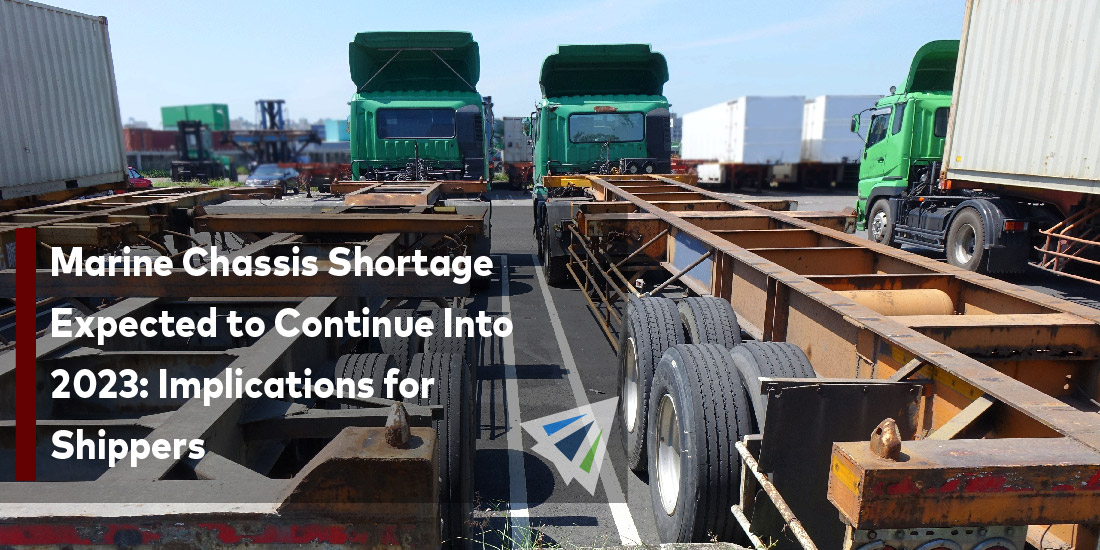Marine Chassis Shortage Expected to Continue Into 2023: Implications for Shippers
The equipment shortage has been brutal for shippers across the country, making it costly, inefficient, and slow to get cargo to and from ocean ports. Unfortunately, the general opinion among industry experts is that this equipment shortage—specifically for marine chassis—is expected to last quite some time. Most likely, the shortage will take until 2023 before improvements begin to show.
The shortage is not just due to inefficient movement and returns of marine chassis. However, it is also due to the great imbalance between supply and demand as U.S. imports have surged in the last several months. Anyone following port news has heard of the increased container dwell times on port grounds, both because importers are taking longer to unload cargo and shipping lines are rolling export bookings.
Many marine chassis manufacturers are making attempts to produce new equipment quickly, but they are being met with several challenges along the way. Firstly, hiring employees is difficult in current market conditions, and as one might guess, acquiring the subcomponents is also difficult (perhaps due to the chassis shortage). Originally, chassis manufacturers were expecting to have balanced the demand with newly manufactured chassis by the third quarter of 2022, but that timeline has been delayed into 2023.
Originally, manufacturers roughly estimated a production of over 120,000 chassis, but realists are predicting the number to be at or below 80,000 for 2022. Currently, production is expected to come in around 30,000 chassis behind what they need to produce in order to balance out demand.
South Carolina Ports Authority (SCPA) was originally planning on launching its proprietary chassis pool at the end of this year into early 2023, but the project is being delayed conservatively to April 2023, as they weren’t able to get the needed 12,900 chassis in 2022. The pressure of the shortage is being felt all across the U.S. though.
Containers Left in Place
The heavy surge of cargo coming into the U.S. has skewed the natural flow of containers between ports. Regional warehouses get filled almost immediately as cargo is unloaded from ships, making it difficult to deal with containers after they are emptied. Rather than efficiently returning empty containers and chassis, importers often leave them either in the port, in a dray lot, or parked outside the warehouse.
While leaving them in the port results in demurrage fees, putting them in a dray lot or outside the warehouse is financially safe for businesses. However, this decision causes chassis to sit for days or weeks before being returned.
This container congestion has been solely responsible for the backlog of two dozen vessels at anchor outside of the Port of Charleston. Over 7,000 containers have sat on port grounds for over two weeks, and more than 3,000 of those have been there for a month. Once again, a conservative estimate puts vessel congestion relief out to late-April for South Carolina ports.
Increasing the supply of chassis is surely expected to help alleviate congestion, but container dwell times may never return to their pre-pandemic levels due to drop lots. Drop lots are likely to remain as truckers have begun using them for efficiency-sake to pull containers out of ports during free time even if cargo owners cannot receive the delivery for several days.
Delays Due to Staffing
The labor shortage is creating major issues for manufacturers attempting to produce the necessary number of chassis to meet shipping demand. Competition is high for lots of industries and manufacturing is not the most attractive one to waltz into at this time.
Factory workers are required to do incredibly laborious work for long hours while wearing a mask. More people are resigning from these companies rather than joining making it difficult for manufacturers to give an accurate estimate on when they may catch up to current demand.
And of course, as previously stated, these international shipping issues apply directly to the manufacturers as well. Acquiring subcomponents like axles, air tanks, tires, and wiring harnesses are incredibly difficult with current congestion and marine chassis shortages.
If you would like more information regarding this topic, contact our team at InterlogUSA and we will be happy to assist you on any questions or comments you may have. In addition, we have our weekly market updates that can provide you with relevant freight news, updates, developments across the industry, and more.
